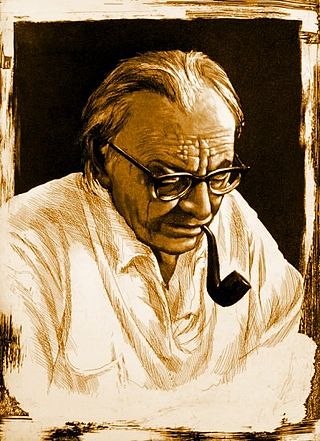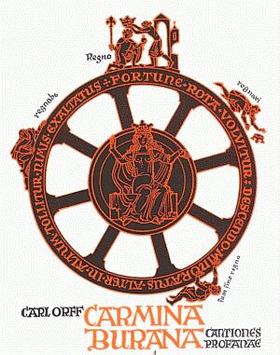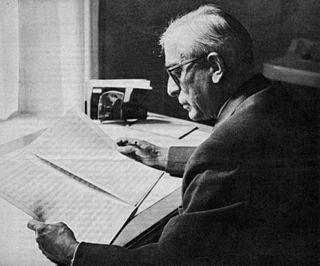
Carl Heinrich Maria Orff was a German composer and music educator, best known for his cantata Carmina Burana (1937). The concepts of his Schulwerk were influential for children's music education.

Antigonae (Antigone), written by Carl Orff, was first presented on 9 August 1949 under the direction of Ferenc Fricsay in the Felsenreitschule, Salzburg, Austria, as part of the Salzburg Festival. Antigonae is in Orff's words a "musical setting" for the Greek tragedy of the same name by Sophocles. However, it functions as an opera.

Catulli Carmina is a cantata by Carl Orff dating from 1940–1943. He described it as ludi scaenici. The work mostly sets poems of the Latin poet Catullus to music, with some text by the composer. Catulli Carmina is part of Trionfi, the musical trilogy that also includes the Carmina Burana and Trionfo di Afrodite. It is scored for a full mixed choir, soprano and tenor soloists, and an entirely percussive orchestra – possibly inspired by Stravinsky's Les noces – consisting of four pianos, timpani, bass drum, 3 tambourines, triangle, castanets, maracas, suspended and crash cymbals, antique cymbal, tam-tam, lithophone, metallophone, 2 glockenspiels, wood block, xylophone, and tenor xylophone.

Trionfo di Afrodite is a cantata written in 1951 by the German composer Carl Orff. It is the third and final installment in the Trionfi musical trilogy, which also includes Carmina Burana (1937) and Catulli Carmina (1943).

Helmut Friedrich Lachenmann is a German composer of contemporary classical music. His work has been associated with "instrumental musique concrète".
SATB is an initialism that describes the scoring of compositions for choirs, and also choirs of instruments. The initials are for the voice types: S for soprano, A for alto, T for tenor and B for bass.

Klaus Huber was a Swiss composer and academic based in Basel and Freiburg. Among his students were Brian Ferneyhough, Michael Jarrell, Younghi Pagh-Paan, Toshio Hosokawa, Wolfgang Rihm, and Kaija Saariaho. He received the Ernst von Siemens Music Prize in 2009, among other awards.

Werner Egk, born Werner Joseph Mayer, was a German composer.
The Spring Symphony is a choral symphony by Benjamin Britten, his Opus 44. It is dedicated to Serge Koussevitzky and the Boston Symphony Orchestra. It was premiered in the Concertgebouw, Amsterdam, on Thursday 14 July 1949 as part of the Holland Festival, when the composer was 35. At the premiere the tenor soloist was Peter Pears, the soprano Jo Vincent and the contralto Kathleen Ferrier. The conductor was Eduard van Beinum. A recording of the performance survives and was first issued by Decca in August 1994.

Carmina Burana is a cantata composed in 1935 and 1936 by Carl Orff, based on 24 poems from the medieval collection Carmina Burana. Its full Latin title is Carmina Burana: Cantiones profanae cantoribus et choris cantandae comitantibus instrumentis atque imaginibus magicis. It was first performed by the Oper Frankfurt on 8 June 1937. It is part of Trionfi, a musical triptych that also includes Catulli Carmina and Trionfo di Afrodite. The first and last sections of the piece are called "Fortuna Imperatrix Mundi" and start with "O Fortuna".

Marek Kopelent was a Czech composer, music editor and academic teacher, who is considered to have been at the forefront of the "New Music" movement, and was one of the most-published Czech composers of the second half of the 20th century.

Conrad Arthur Beck was a Swiss composer.
Symphony in B-flat for Band was written by the German composer Paul Hindemith in 1951. It was premiered on April 5 of that year by the U.S. Army Band "Pershing's Own" with the composer conducting.
Adriana Hölszky is a Romanian-born German music educator, composer and pianist who has been living in Germany since 1976.
Éjszaka and Reggel, sometimes also referred to as Éjszaka és reggel or Ejszaka, Reggel, are twin vocal compositions by Hungarian-Austrian composer György Ligeti. They were published as a set and are usually performed and recorded together.
Théo De Joncker was a Belgian composer.

Prometheus is an opera by Carl Orff. The opera's Greek text is based on the drama by Aeschylus, the only surviving part of his Prometheus trilogy. Since Aeschylus’s text in Ancient Greek has been directly set to music without alterations or cuts, Orff’s score qualifies as one of the most typical examples for the operatic genre of Literaturoper. The premiere took place on March 24, 1968 at Staatstheater Stuttgart under the direction of Ferdinand Leitner in a production by Rudolf Sellner with sets and costumes by Teo Otto.
Lothar Windsperger was a German composer as well as long-standing literary editor and publisher at Schott.
Wilfried Hiller is a German composer. He became known above all for his stage works for families, children and young people.

Boris Carmeli was a Polish operatic basso profondo known for his "fervent rich hued tones" and extensive repertory of more than 70 operas and 60 oratorios. During his long career, he appeared regularly at La Scala in Milan and other major opera houses internationally. In addition to the classical bass repertoire, he performed contemporary music including major works by Krzysztof Penderecki and Karlheinz Stockhausen. He appeared at international music festivals, on Italian television, and in many opera films.









